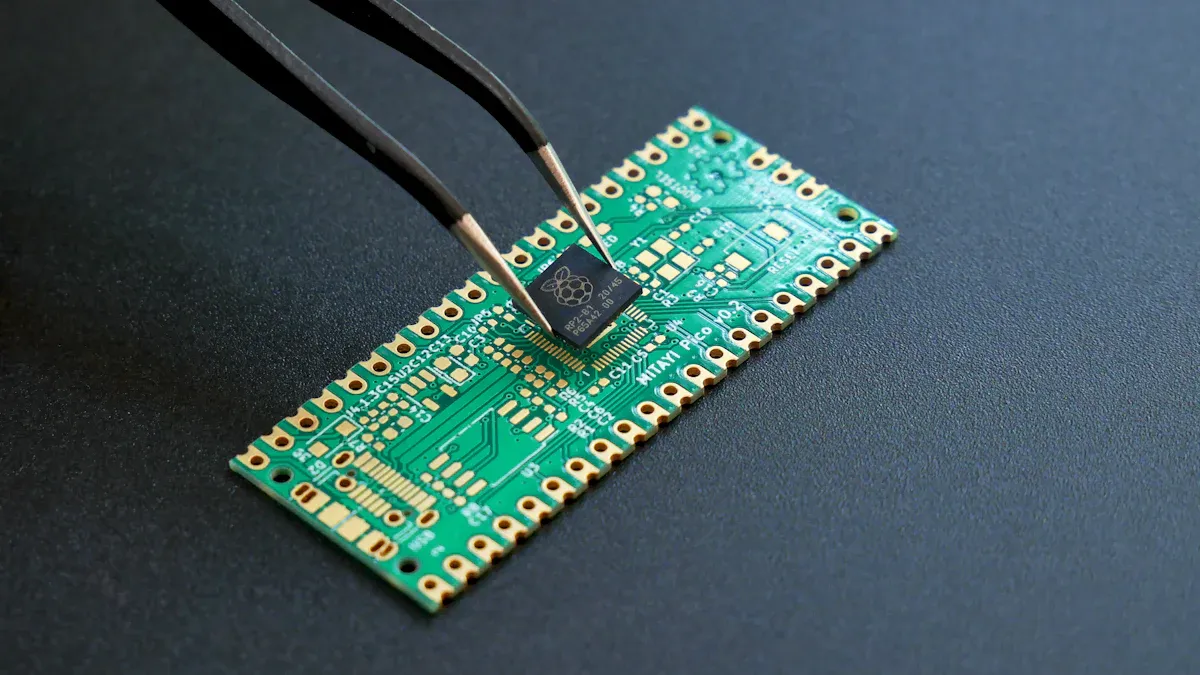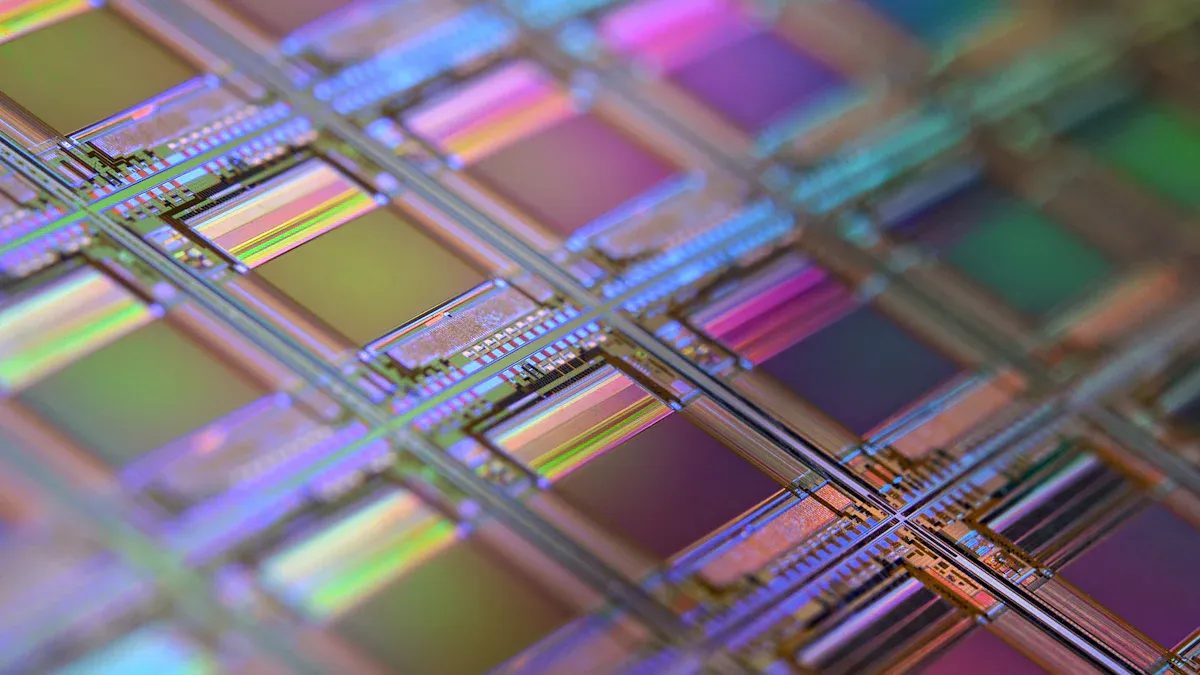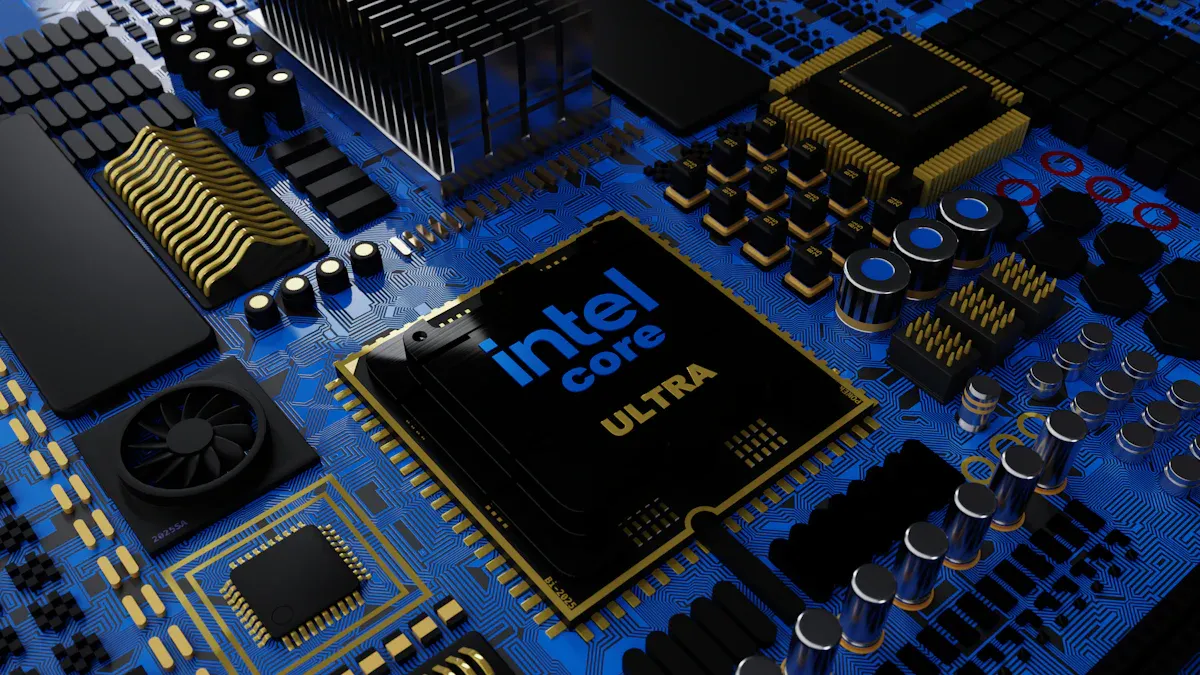What is an Integrated Circuit in Electronics

An integrated circuit, often called a microchip or chip, acts as the brain of many electronic devices. It combines tiny parts like transistors and resistors onto a small piece of silicon. This design helps ic electronics work faster and use less space. People find these chips in phones, computers, and many household gadgets. By placing many components together, integrated circuits make modern technology possible.
Key Takeaways
Integrated circuits combine many tiny electronic parts on a small chip, making devices faster, smaller, and more efficient.
ICs contain key components like transistors, resistors, capacitors, and microprocessors that work together to process and control electrical signals.
Different types of ICs—analog, digital, and mixed-signal—handle various tasks, from processing real-world signals to running complex programs.
ICs power everyday devices such as smartphones, computers, appliances, and industrial machines, improving performance and saving energy.
The small size and reliable design of ICs lower costs, increase durability, and enable advanced technology in many fields.
What is an IC

Integrated circuits, or ICs, form the foundation of modern electronic devices. These tiny chips combine many electronic parts into a single, compact unit. ICs allow devices to perform complex tasks while staying small and efficient. People find ic electronics in everything from smartphones to washing machines.
IC Structure
The structure of an integrated circuit starts with a thin slice of semiconductor material, usually silicon. Engineers build many layers on this base to create the final chip. Each layer has a special job in making the IC work.
Note: The structure of an IC is like a multi-layered cake, where each layer adds a new function or connection.
Here is a table showing the main layers found in a typical silicon-based IC:
Layer | Description |
|---|---|
Silicon Substrate | The base layer that supports all other layers |
Doped Regions | Areas with added materials to form transistors and other components |
Metal Interconnect Layers | Thin metal tracks (often copper or aluminum) that connect different parts |
Insulating Layers | Layers of silicon dioxide that separate metal tracks |
Vias | Tiny holes filled with metal to connect layers vertically |
Protective Cap | A top layer, often silicon nitride, that shields the chip from damage |
Bond Pads | Spots where wires connect the chip to the outside world |
Engineers use these layers to pack thousands or even billions of components into a space smaller than a fingernail. This design makes ic electronics both powerful and compact.
IC Components
Inside every integrated circuit, several key components work together to perform electronic functions. These components include:
Transistors: Act as tiny switches or amplifiers. They control the flow of electricity and form the building blocks of logic circuits.
Resistors: Limit or control the amount of current flowing through the circuit.
Capacitors: Store and release electrical energy as needed, helping to smooth out voltage changes.
Diodes: Allow current to flow in only one direction, protecting other parts of the circuit.
Microprocessors: In more advanced ICs, these act as the "brains," performing calculations and logic operations.
All these components are connected by thin metal wires built into the chip. The combination of these parts allows ic electronics to handle tasks like processing information, storing data, and controlling other devices.
Integrated circuits use materials such as silicon for the base, copper or aluminum for wiring, and special adhesives and resins for protection. These choices help make ICs reliable and long-lasting.
How ICs Work
Electronic Functions
Integrated circuits perform many important tasks in electronic devices. They use transistors, resistors, and capacitors to control and process electrical signals. Transistors act as tiny switches. These switches turn signals on or off, which helps the circuit make decisions. This switching action allows ICs to carry out logical operations, such as adding numbers or comparing values. Digital ICs work with binary data, using patterns of ones and zeros to store and process information. Microprocessors, which are advanced ICs, use millions of transistors to solve complex problems and run programs.
ICs also handle other functions. Some amplify weak signals, making them stronger for speakers or antennas. Others store data, like the memory chips in computers. Analog ICs process signals that change smoothly, such as sound or light. Digital ICs, on the other hand, work with signals that have only two levels: high or low. This difference lets ic electronics perform many roles, from controlling lights to running entire computers.
ICs use transistor-based switching to perform logical operations. This method allows them to process information quickly and efficiently, making them essential for modern technology.
Integration Process
The creation of an integrated circuit involves several careful steps. Engineers start with a thin slice of silicon, called a wafer. They use special techniques to build up the different parts of the circuit on this wafer. The process includes the following steps:
Photolithography: Engineers use light to draw tiny patterns on the silicon wafer. These patterns show where each part of the circuit will go.
Deposition: Thin layers of materials, such as metals or silicon compounds, are added to the wafer.
Etching: Unwanted material is removed, leaving behind the shapes needed for the circuit.
Doping: Small amounts of other elements are added to the silicon. This step changes how the silicon conducts electricity, creating areas for transistors and resistors.
Cleaning: The wafer is cleaned to remove any dust or leftover chemicals.
Packaging and Assembly: The finished chip is placed in a protective case. Tiny wires connect the chip to the outside world, so it can work inside electronic devices.
Each step must be very precise. Even a small mistake can cause the IC to fail. By following these steps, engineers can fit thousands or even billions of components onto a single chip. This process makes ic electronics powerful and reliable, while keeping them small enough to fit in everyday devices.
The integration process allows engineers to combine many electronic parts on one chip. This method saves space and improves performance, which is why ICs are found in so many modern products.
Types of ICs

Integrated circuits come in several types, each designed for specific tasks in electronic devices. The table below shows a basic classification of common IC types and their examples:
Category | Description & Examples |
|---|---|
Analog ICs | Amplifiers, filters, operational amplifiers, power management circuits |
Digital ICs | Logic gates, memory chips, microprocessors, digital signal processors (DSPs), microcontrollers, ASICs |
Mixed-Signal ICs | Combine analog and digital functions, such as analog-to-digital converters (ADCs) and digital-to-analog converters (DACs) |
Analog ICs
Analog ICs work with signals that change smoothly, like sound or temperature. These chips play a key role in real-time signal processing. For example, medical equipment uses analog ICs to read heartbeats or muscle signals. Sports headphones rely on analog circuits for clear sound. Smart clothing uses them to measure temperature and humidity. Many sensors in industrial and biomedical devices also depend on analog ICs for accurate readings. These chips help devices handle real-world signals before any digital processing happens.
Tip: Analog ICs provide high precision and low noise, making them perfect for portable and wearable devices.
Digital ICs
Digital ICs process information using binary signals—ones and zeros. These chips perform logical operations, store data, and control how information moves inside devices. Microprocessors and microcontrollers act as the brains of computers and smart gadgets. Digital ICs also include memory chips and logic gates. They help run programs, manage data, and control many features in modern electronics.
Digital ICs are found in computers, smartphones, and many ic electronics products.
Application-Specific Integrated Circuits (ASICs) and Field-Programmable Gate Arrays (FPGAs) are special digital ICs for custom tasks.
Mixed-Signal ICs
Mixed-signal ICs combine both analog and digital parts on a single chip. This design lets devices handle real-world signals and digital data at the same time. For example, a fitness tracker uses mixed-signal ICs to read heart rate (analog) and then process the data (digital). These chips save space and improve power efficiency. Mixed-signal ICs are important in communication, healthcare, and consumer electronics.
Memory ICs
Memory ICs store data for computers, phones, and other devices. They come in different sizes and types. For example, SDRAM chips in consumer electronics often have capacities from 64Mb to 128Mb. As people use more data, devices need larger and faster memory ICs. These chips help store photos, apps, and system information.
ASICs
ASICs, or Application-Specific Integrated Circuits, are custom chips made for special jobs. In telecommunications, ASICs help routers and switches move data quickly. Cryptocurrency miners use ASICs for fast calculations. Cars use ASICs to process data from cameras and sensors, improving safety and control. Aerospace systems rely on ASICs for navigation and communication. Consumer devices like smartphones use ASICs for better camera performance and longer battery life.
IC Electronics Applications
Consumer Devices
Integrated circuits power many devices people use every day. These chips help smartphones and mobile devices process data, connect to wireless networks, and display high-quality visuals. Computers and laptops rely on ICs for fast calculations, smooth software operation, and reliable data storage. Many household appliances, such as refrigerators and washing machines, use ICs to control temperature, motor speed, and energy use. Entertainment systems, including smart TVs and multimedia players, depend on ICs for clear audio and vibrant video. Gaming consoles and virtual reality headsets also use specialized ICs to create lifelike graphics and manage controls.
Did you know? By 2025, experts expect 75% of people worldwide to own a smartphone, showing how important ICs are in daily life.
Common consumer devices that use ICs:
Smartphones and mobile devices
Computers and laptops
Household appliances
Entertainment systems
Gaming consoles and VR headsets
Industrial Uses
Factories and industrial plants use ic electronics to improve automation and control. Integrated circuits form the core of controllers like PLCs and distributed control systems. These controllers monitor sensors and manage machines, such as robotic arms or conveyor belts. ICs help measure temperature, pressure, and motion, making sure equipment runs safely and efficiently. As factories grow more complex, IC-based systems allow for better communication and easier management. Central control rooms use these systems to monitor and adjust processes in real time, which increases reliability and performance.
Communication
Modern communication depends on integrated circuits. ICs make devices smaller, faster, and more energy-efficient. Smartphones use system-on-a-chip ICs that combine processors, memory, and modems for wireless communication. Routers and network equipment rely on high-speed ICs to handle large amounts of data quickly and with low delay. ICs also support 5G technology, which brings faster internet and more reliable connections. These advances allow people to connect, share, and access information from almost anywhere.
Integrated circuits drive innovation in communication, making devices more powerful and keeping people connected around the world.
IC Advantages
Size & Efficiency
Integrated circuits help make electronic devices smaller and more powerful. Engineers can fit more transistors into a tiny chip by using advanced manufacturing methods. This process, called miniaturization, increases transistor density. As a result, devices run faster and use less energy. Technologies like MOSFET scaling and special packaging methods, such as Ball Grid Arrays (BGAs), allow chips to have more connections in a smaller space. Wafer-level chip-scale packaging and Chip-on-Board assembly also help reduce the size of components. These methods let engineers build compact modules with shorter signal paths, which improves speed and signal quality. Because of these advances, people can carry smartphones, tablets, and other portable devices that fit easily in a pocket or bag.
Tip: Smaller chips mean less heat and better battery life for portable electronics.
Reliability
ICs offer high reliability because they have fewer physical connections and moving parts than older electronic designs. The components inside an IC sit close together, which reduces the chance of loose wires or broken connections. Manufacturers test each chip carefully to make sure it works as expected. The protective layers on the chip shield it from dust, moisture, and damage. This design helps ICs last longer and work well in many environments, from home electronics to industrial machines.
Key reasons for IC reliability:
Fewer soldered joints
Strong protective coatings
Automated testing during production
Cost
Integrated circuits lower the cost of making electronic devices. Factories can produce thousands of chips at once using the same silicon wafer. This process, called mass production, reduces the price per chip. ICs also use less material and take up less space, which saves money on parts and assembly. Because ICs are small and efficient, companies can design affordable products for more people. Lower costs help bring technology to schools, homes, and businesses around the world.
ICs make advanced technology more accessible by keeping prices low and quality high.
Analog vs Digital ICs
Differences
Analog and digital integrated circuits handle signals in different ways. Analog ICs work with continuous signals that can have any value within a range. These circuits use components like resistors, capacitors, and transistors. They process real-world signals such as sound, light, or temperature directly. Digital ICs, on the other hand, use discrete signals. These signals have only two states, often shown as 0 and 1. Digital circuits use logic gates and microcontrollers to process information.
The table below shows the main differences between analog and digital ICs:
Aspect | Analog ICs | Digital ICs |
|---|---|---|
Signal Type | Continuous signals | Discrete signals (0 or 1) |
Noise Susceptibility | More affected by noise | Less affected by noise |
Circuit Components | Resistors, capacitors, transistors | Logic gates, microcontrollers |
Operation Mode | Synchronous (uses a clock signal) | |
Processing Speed | Slower | Faster |
Accuracy | Lower accuracy | |
Power Consumption | Higher | Lower |
Design Complexity | More complex | Easier with software tools |
Analog circuits often face more noise, while digital circuits resist noise better. Digital ICs also use less power and work faster.
Uses
Engineers choose analog or digital ICs based on the job they need to do. Analog ICs are best for tasks that involve real-world signals. For example, operational amplifiers boost weak audio signals in microphones. Voltage regulators keep power steady in chargers. Power amplifiers drive speakers in radios. Sensors that measure temperature or pressure use analog ICs to read changes smoothly.
Digital ICs shine in devices that need fast and accurate data processing. Computers, smartphones, and game consoles use digital ICs to run programs and store information. Digital signal processors filter music and compress videos. Microcontrollers control robots, washing machines, and smart home devices.
Analog ICs are common in:
Audio amplifiers
Voltage regulators
Sensors and transducers
Modulators and demodulators
Digital ICs are common in:
Computers and smartphones
Memory chips
Logic controllers
Digital signal processors
Analog ICs connect devices to the real world, while digital ICs handle data and logic inside modern electronics.
Integrated circuits shape the world of electronics by making devices smaller, faster, and more efficient. Over the years, ICs have driven major changes in technology and industry:
Aspect | Impact |
|---|---|
Enabled compact, high-performance devices | |
Supported 3D stacking and advanced chip designs | |
Market Growth | |
Energy Efficiency | Improved battery life and reduced power use in modern electronics |
Industry Transformation | Advanced sectors like IoT, automotive, and computing |
People benefit from ICs every day. Smart sensors, AI-powered chips, and energy-saving designs help create safer homes, better healthcare, and smarter cities. As technology advances, ICs will continue to power new ideas and improve daily life for everyone.
FAQ
What is the main purpose of an integrated circuit?
An integrated circuit helps electronic devices work by combining many small parts on one chip. This design saves space and makes devices faster and more reliable.
Where can people find integrated circuits in daily life?
People see integrated circuits in smartphones, computers, cars, and home appliances. These chips help control screens, store data, and manage power in many modern products.
How do integrated circuits save energy?
Integrated circuits use less power because they fit many parts into a small area. This design reduces energy loss and helps devices run longer on batteries.
Can integrated circuits break easily?
Most integrated circuits last a long time. Protective layers shield them from dust and moisture. Manufacturers test each chip to make sure it works well in different conditions.
Why do engineers use silicon for integrated circuits?
Silicon works well as a base for chips. It conducts electricity in a controlled way. This property helps engineers build reliable and efficient circuits for many devices.
See Also
Exploring The Importance Of Integrated Circuits In Electronics
A Comprehensive Guide To Digital Integrated Electronic Circuits
How Fully Integrated Processors Function And Their Key Features
Understanding Integrated Battery Monitor ICs And Their Operation
